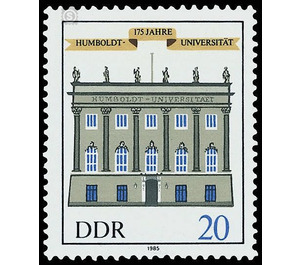175 years - Germany / German Democratic Republic 1985 - 20 Pfennig
Theme: Architecture
| Country | Germany / German Democratic Republic |
| Issue Date | 1985 |
| Face Value | 20.00 |
| Color | grey |
| Perforation | K 14 |
| Printing Type | offset |
| Stamp Type | Postage stamp |
| Item Type | Stamp |
| Chronological Issue Number | 2722 |
| Chronological Chapter | GER-DDR |
| SID | 901750 |
| In 24 Wishlists | |
175 years Humboldt University and 275 years Charité On the occasion of the 175th anniversary of the Humboldt University and the 275th anniversary of the Charité zu Berlin, the Ministry of Posts and Telecommunications of the German Democratic Republic publishes two multicolored special postage stamps. Special cancellation from 22 October to 21 December 1985 175 years Humboldt University of Berlin and 275 years Berlin Charité The double jubilee 1985 is a significant event in the political and scientific life of the University. For this anniversary, just before the XI. The members of the Humboldt University in Berlin will give an account of the results of their work and explain how they fulfill the demands made of the X. Party Congress on the scientists. In addition, the double jubilee in preparation for the anniversary of the city of Berlin in 1987 is of particular importance. The Humboldt University and its affiliated department of medicine (Charité) are traditional places of teaching, research and medical care. Internationally known scientists who worked here in the beginning and at the beginning of the century founded the world reputation of the University and Charité. After Wilhelm von Humboldt had founded the University of Berlin as a "universitas litterarum" in 1810, his conception of education and education, to combine research and teaching organically, and to serve universal humanistic education, could be realized. His widely traveled brother Alexander von Humboldt, naturalist and humanist, promoted the international reputation of the university. He gave rise to important impulses for the development of the natural sciences. With his famous "Cosmos lectures" he founded the tradition of public lectures, which is continued today with Sunday lectures and evening classes for the Berlin population. Since February 8, 1949, the University of Berlin bears the honorable and obligatory name of the Humboldt brothers. Well-known scientists have taught since its foundation at the University of Berlin. The philosopher J. G. Fichte was the first elected rector. In 1818 G. W. Hege], the most important philosopher of his epoch and founder of the dialectical method, was called. A. D. Thaer was Professor of Agricultural Science, F. K. von Savigny Professor of Roman Law. From 1836 to 1841 Karl Marx, the founder of scientific socialism, studied law and philosophy at the University of Berlin. F. Engels, co-founder of scientific socialism, was a guest auditor from 1841 to 1843. Other personalities who studied here were: Heinrich Heine, Ludwig Feuerbach, Ernst Haeckel, Heinrich Hertz and Karl Liebknecht. The stormy capitalist industrialization of the last century brought about a tremendous upswing in science at the University of Berlin. The awarding of the Nobel Prize to E. Fischer, W. Nernst, 0 Hahn, M. Planck, M. v.. Laue, A. Einstein and M. Born testify to this. The Berlin Charité, built in 1710, has been a clinical training center since 1724. In 1829 she was incorporated into the University. C W. Hufeland was the first dean. Outstanding scientists and physicians caused by their achievements worldwide reputation of the Berlin Charité. These include, among many others: B, v. Langenbeck, A. v. Graefe, R. Virchow, W. Griesinger, R. Koch, F. Sauerbruch. After the liberation from fascism, the university was reopened in 1946 and the Berlin Vorstudienanstalt was founded, from which the Arbeiter-und-Bauern-Faculty (ABF) emerged in 1949. Since 1951, the socialist transformation of the university has been carried out according to the level of development of socialist society in the GDR. Since then, the university has become a major scientific and cultural center with a great international appeal. In 1984, the University received the Karl Marx Order for high achievements in teaching and education, scientific development and research as well as health care. 20 Pfennig value: Main building of the Humboldt University to Berlin 1745 to 1764 as Prinzenpalais Unter den Linden by Johann von Boumann and Johann Lukas of Hildebrandt to plans of Georg Wenzeslaus of Knobelsdorff built.


